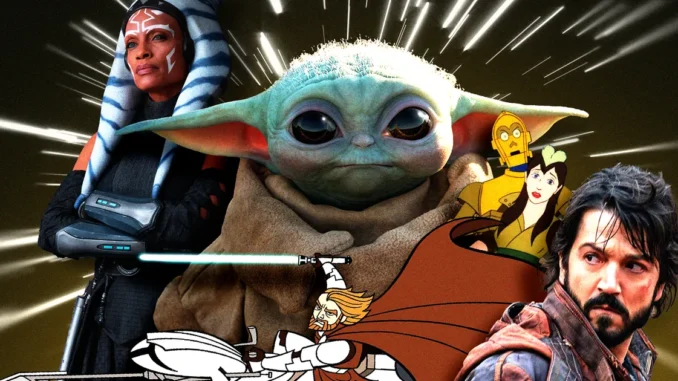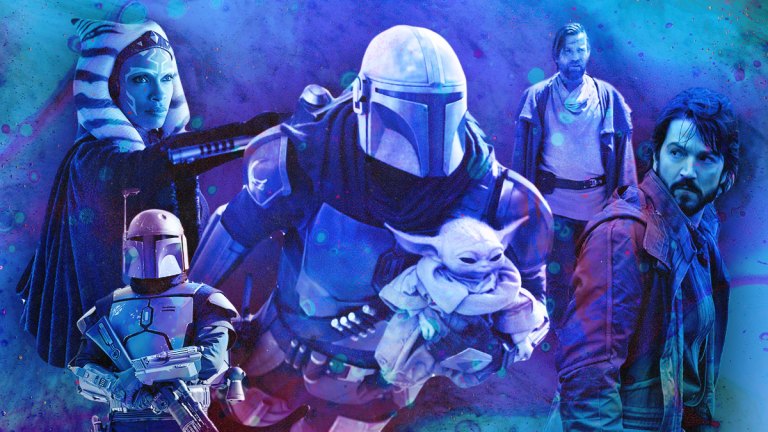
Star Wars Live-Action TV Shows Ranked From Worst to Best
With five shows now out on Disney+, it’s time to rank the Star Wars live-action series!

In 2019, The Mandalorian kicked off a new era of Star Wars storytelling on the small screen and the saga hasn’t slowed down since. From Mandalorian spinoffs The Book of Boba Fett and Ahsoka to jumps back in time for Obi-Wan Kenobi and Andor, the franchise has expanded beyond the movies to explore new characters, eras, and settings in the serialized format that first inspired George Lucas to make Star Wars.
This all means that Star Wars fans are absolutely spoiled for choice on Disney+, but which TV series is best? We’ve ranked the good, the bad, and the scruffy-looking nerf herders of the lot.
5. The Book of Boba Fett
Boba Fett made his triumphant return to live action in 2020 on The Mandalorian before jumping into his own series about taking over Jabba the Hutt’s former territory. On paper, the galaxy’s deadliest bounty hunter becoming its most dangerous crime lord might seem like a dream come true, but in execution, The Book of Boba Fett amounts to less than a series of side quests on cheap-looking sets. And that’s when Boba Fett is actually allowed to star in his own show.
Stripped of any real grit or bite, and largely relegated to board meetings, taking naps in a bacta tank, and running errands around Tatooine, Boba doesn’t get all that much to do as the new daimyo of Mos Espa, and the flashbacks that tell us how the bounty hunter survived the ordeals that followed his demise in Return of the Jedi never really surprised but instead overexplained. Despite one or two memorable action sequences, including one featuring a baby rancor, the show just never really gets going — except when its protagonist is unceremoniously ushered off the stage completely so that the series can follow up on a largely unrelated story about different characters, a choice that remains one of the biggest head-scratchers of the Disney era. Boba Fett and star Temuera Morrison, who is as charismatic as ever in spite of the questionable material, deserved much better than this book.
4. Obi-Wan Kenobi
This continuation of Obi-Wan Kenobi and Anakin Skywalker’s stories was a highly-anticipated event for a generation of Star Wars fans who grew up with the Prequels. Seeing Ewan McGregor and Hayden Christensen back in their respective roles certainly pulls at the heart strings, but Obi-Wan Kenobi falls short of the epic scale one would expect from such a big reunion. The show plods along for its first couple of episodes, with the action and Obi-Wan sulking taking place on surprisingly artificial-looking sets that never live up to the standard of the other Disney+ shows. The cave sets on Jabiim have a particularly distracting styrofoam quality, while the final showdown on a fog-covered wasteland makes it painfully obvious this is all unfolding on a Lucasfilm soundstage.
All that said, Obi-Wan Kenobi has some top-notch performances from McGregor, Christensen, and especially newcomer Moses Ingram. She plays an Inquisitor named Reva, who you may or may not end up rooting for by the end. Bringing in Vivien Lyra Blair as a younger, influential Princess Leia to pal around with a battered and depressed Old Ben came off as cheap sentimentality and nostalgia to some (seriously, your mileage may vary with this Star Wars series in particular), but we’ d actually call it a stroke of genius. It’s Obi-Wan’s relationship with little Leia that ends up being the emotional hook of the show. And you get some scary moments with Darth Vader as a bonus.
3. Ahsoka
Ahsoka is certainly not lacking in big ideas — evil Force witches, zombie stormtroopers, new galaxies, and even time travel from a certain point of view — or nostalgia for the Star Wars stories that came before. But, while it’s an entertaining watch overall, especially if you’ve tuned into the Rebels animated series and read the old Legends novels starring Grand Admiral Thrawn, and does eventually push the story of the Mandoverse forward, it makes many of the same mistakes as some of its predecessors. For one thing, Ahsoka never actually feels like it centers its main character or interrogates her feelings about everything — a common issue across most of the recent Disney+ shows. The series also suffers from “eight-part movie syndrome,” with several episodes ending abruptly (or really not at all) or slowing down to a crawl because they’re in no real hurry to get to the interesting bits. And when the show does reach its big turning point on Peridia, the reunions and rematches do feel a tad underwhelming after six episodes of build-up.
Still, there’s a lot to like in what showrunner Dave Filoni has cooked up, including plenty of references to The Lord of the Rings, mystical planes, and even a few Force gods. Star Wars has also found an absolute star in Natasha Liu Bordizzo, who’s all but stole the show by the third act. You may at first tune into this show for Ahsoka, Thrawn, and Ezra, but there’s no doubt you’ll stay for Bordizzo’s Sabine, as it’s her story that turns out to be the heart of this series.
Credit must also be given to the visuals and cinematic look of Ahsoka. A combination of Lucasfilm’s trademark video wall and CGI helps bring scenes on exotic planets to life as well as the multiple dogfights in space. Not many Star Wars series look anywhere near this good. It’s just a shame the show doesn’t have the pacing or central character to match.
2. The Mandalorian
Three seasons in, with a fourth reported on the way, few would question The Mandalorian‘s impact on the franchise. Not only did Din Djarin’s bounty hunting adventures unlock a whole new era of storytelling for the galaxy far, far away but it also introduced fans to arguably the most popular Star Wars character of the Disney era: the incredibly cute Grogu. Stuffed and animatronic Baby Yodas couldn’t fly off shelves fast enough rare after the first season, the kind of merchandising frenzy that would make George Lucas crack the smile. And Grogu’s a pretty captivating character to boot, a former Jedi padawan lost in space ever since Order 66 and in search of a home. He finds one in the unlikeliest of places: with the bounty hunter who was sent to capture him but is secretly hiding a heart of gold.
Across 24 episodes, including an admittedly weaker third season, we get to watch what is essentially the beginning, middle, and happily ever after (for the moment) of a father and son journey that just so happens to tie in many of the galaxy’s biggest events, such as the liberation of Mandalore and the return of Luke Skywalker. The Mandalorian is not just a heartwarming tale though, it’s also innovative, which should always be one of the key ingredients of a major new Star Wars property.
This was the first TV series to use ILM’s StageCraft tech, better known as the Volume, which allows the show to visit faraway planets like Tatooine and Trask without filming in Tunisia or Croatia or having to use green screen. As a demo for what the tech could do in 2020, it was damn impressive, unlocking new possibilities for TV visuals on a budget. Most of the other live-action Star Wars series on Disney+ have embraced this tech since, but there’s no question that The Mandalorian still does it best.
1. Andor
Tony Gilroy’s vision of an anti-Star Wars Disney+ show feels like it came the hell out of nowhere in 2022. Set years before the events of Rogue One, and starring a lesser known Star Wars character from that film, this underdog of a TV series turned out to be a lesson in what happens when the franchise takes itself seriously. Unapologetically mature and timely, the show’s 12-episode first season throws nostalgia and cheap cameos out of an airlock. Instead, it’s the brilliantly written characters, deft storytelling, and a central message about the sacrifices we must make when staring down the barrel of fascism that drives this stellar series.
At the start of the show, Cassian Andor is not the fully formed Rebel secret agent/hitman we met in Rogue One. A powerful performance from Diego Luna gives us Cassian at his most desperate, a criminal who doesn’t care about the Rebel cause until he lands himself and his impoverished mining town in big trouble with the Empire.
